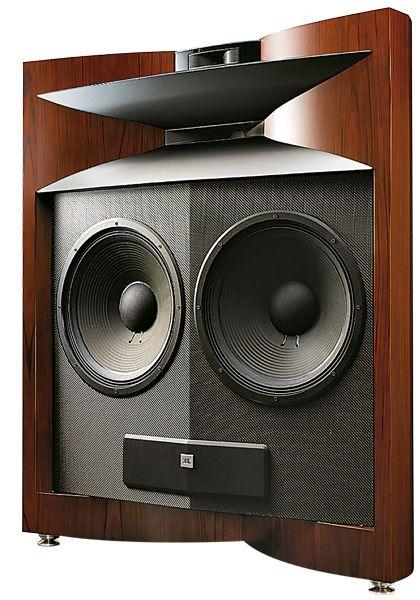Jbl Project Everest Dd67000 (£70,000)

The Everest has been JBL’s flagship ‘Project’ speaker for nearly three decades. Carried over from the out-going model are the speaker’s two horn-loaded beryllium compression drivers: the 100mm diameter 476Be high frequency unit and the 25mm 045Be-1 ‘UHF’ supertweeter, working up to a claimed 60kHz.
The speaker’s curved baffle provides the side-walls for the main high-frequency horn while top and bottom horn flares are accomplished by the attachment of precision moulded Sonoglass horn ‘lips’ to the enclosure’s upper surface. The UHF driver is in a separate Sonoglass horn mounted to a diecast aluminium housing.
What makes the Everest significantly different, of course, is the inclusion of two rather than one 15in woofer. And JBL’s 15in woofers, have been substantially re-engineered [see HFN Aug ’14 for full details].
To exploit these new bass drivers, the Everest’s 45mm-thick hybrid baffle, made from layers of birch plywood and MDF, has been strengthened with a covering of carbon fibre cloth. The cabinet is ported at the rear with a tuning frequency of 32Hz. You can cut or boost the output level of the low-range woofer and also tweak the 476Be HF unit by approximately ±0.4dB over the 1-8kHz range.
Realism!
Play easy-on-the-ear recordings like ‘No Sanctuary Here’ from Chris Jones’ Roadhouses & Automobiles [Stockfisch Records] and you’ll certainly consider the sound ‘nice’ – as you wallow in rich, deep and thickly-textured bass, a warm midrange and appealingly delicate, sparkling highs.
But there’s nothing sweet or delicate about the manner in which the Everest recreates the blast of a trumpet, the wail of a soprano sax, or the sound of wooden sticks striking percussion. The timbre and transient attack of instruments is shockingly real.
We soon lost count of the number of occasions the Everest transfixed us by its sheer honesty. Hi-res audiophile recordings had us spellbound as the speaker divulged the true-to-life sounds of instruments and voices, and their acoustic settings.
As for rock-for-the-boys, Metallica’s eponymous black album sounded cosmic at 96kHz/24-bit ripped from DVD-A [Elektra], as did innumerable prog-rock and jazz-rock masterpieces from the early 1970s.
The Everest doesn’t require a brute of an amp to deliver deafening SPLs, but it is ruthlessly revealing of amplifier quality. It sounded sublime with Levinson’s flagship No53 monoblocks [HFN Jan ’11] which were supplied during the review period to show the Everest at its best.
If you want bone-crushing dynamics this speaker delivers in spades. If you’re chasing electrostatic panel-type soundstage depth and imaging, it provides that too. And if you’ve a penchant for enjoying rock/pop/dub/electronica at, ahem, realistic SPLs, the Everest supplies sufficient slam to be considered an offensive weapon.
Seriously: a pair of Everests will fill a community hall with hi-fi sound without breaking into a sweat, never mind an audiophile’s listening room. If you want music to sound ‘live’, this is where you’ll find it.
Verdict
JBL’s flagship Everests won’t fail to blow you away. They allow forensic inspection of recordings and deliver revelatory detail, yet without any of that ‘matter-of-fact-ness’, often experienced from studio monitors. Simply awesome.
Originally published in the 2014 Yearbook
























































